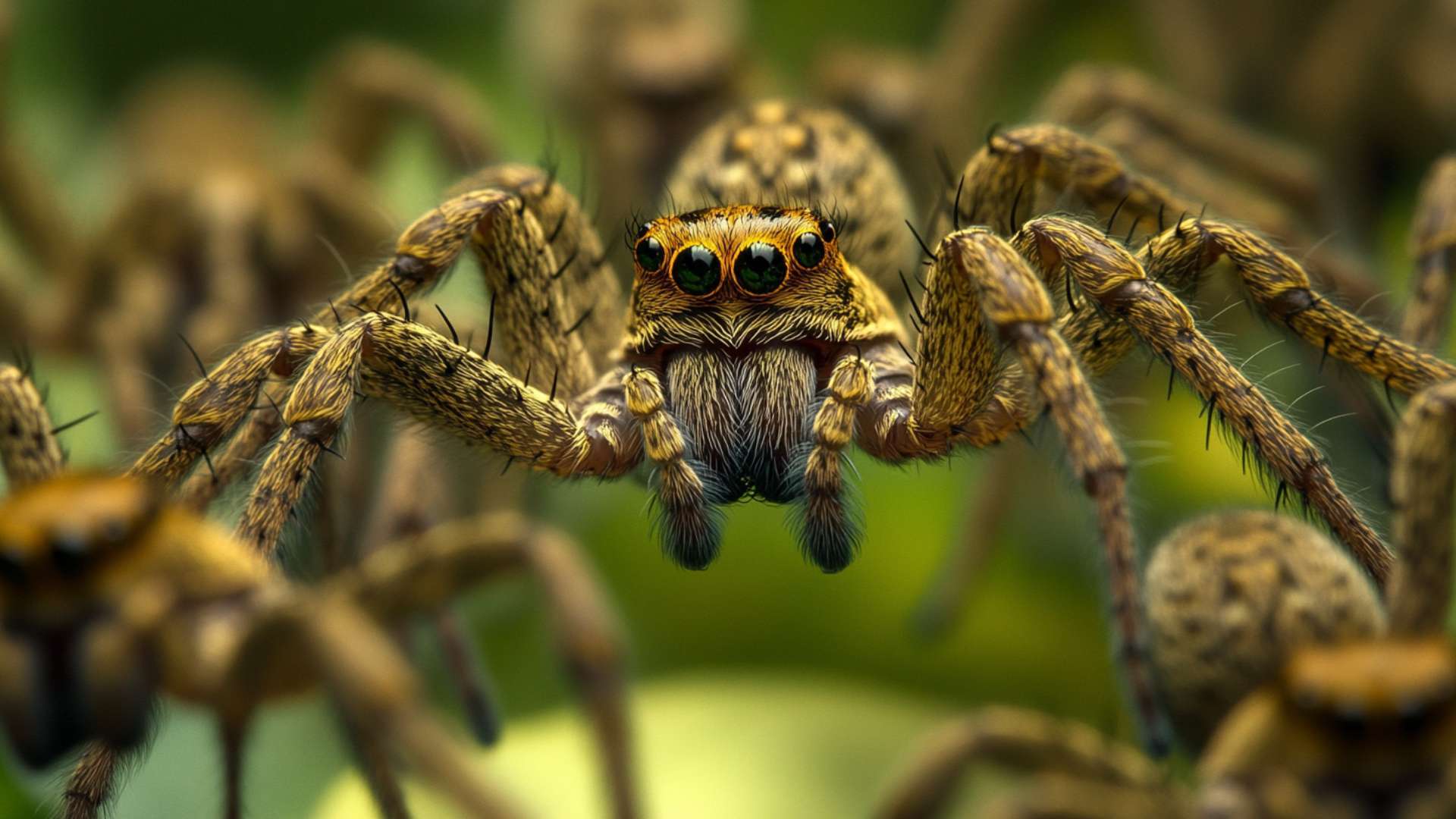Spiders, fascinating creatures belonging to the class Arachnida, are known for their unique and intricate behavior as well as their distinctive characteristics. Found in almost every corner of our planet, spiders exhibit a remarkable diversity of species, with over 45,000 identified so far.
Their presence in various ecosystems plays a crucial role in maintaining ecological balance by controlling insect populations. In this article, we will delve into the captivating world of spider behavior and characteristics.
Explore Our Professional Spider Control and Extermination Services! Uncover the effectiveness of our expert spider control and extermination solutions in addressing your spider infestation. Click here to learn more about our specialized spider control and extermination services!
Definition of Spiders
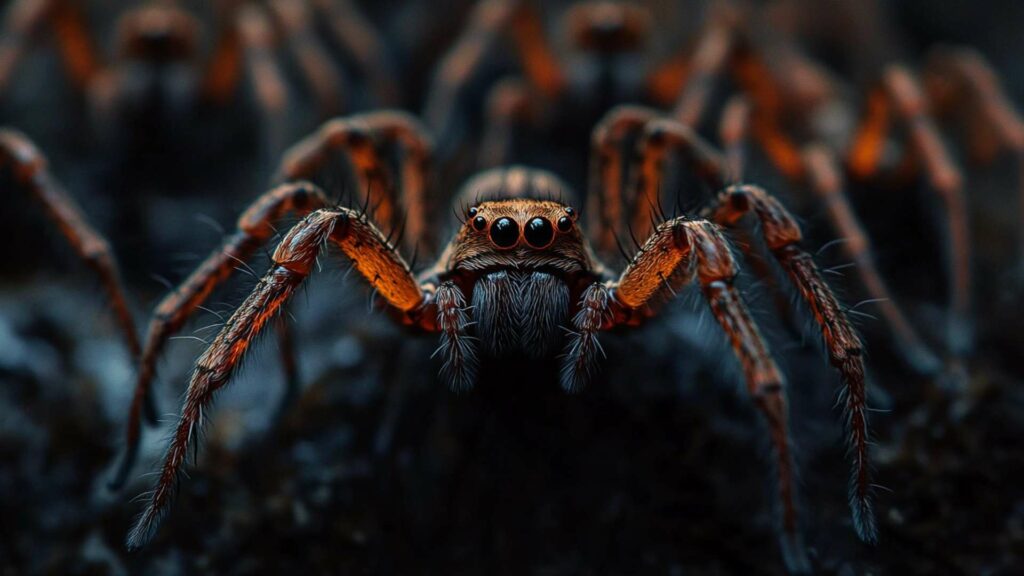
When we think of spiders, what typically comes to mind are eight-legged arachnids that build intricate webs to capture prey. However, the definition of wolf spider extends beyond this common perception.
Spiders are air-breathing arthropods characterized by their chelicerae – specialized appendages containing venom glands used to immobilize and digest their prey. These fascinating creatures have segmented bodies divided into two sections: the cephalothorax (consisting of the head and thorax fused together) and the abdomen.
Overview of Spider Behavior and Characteristics
Spider behavior encompasses a wide array of fascinating patterns that vary among different species. While most spiders build webs as a means for capturing prey efficiently, not all adhere to the same way in this strategy.
Some species employ alternative hunting techniques such as ambush predation or active pursuit hunting methods. One prominent characteristic that sets spiders apart is their ability to produce silk—an incredibly versatile material secreted from specialized abdominal structures called spinnerets.
Silk serves multiple purposes for spiders—ranging from building elaborate webs for prey capture or shelter to creating egg sacs for protection and even assisting in locomotion. Additionally, spiders possess exceptional senses despite lacking ears or noses like many other animals.
They rely primarily on vibrations perceived through sensory hairs on their legs to sense movement in their environment. Many species also have multiple pairs of eyes with varying functions; some eyes are specialized for detecting light intensity variations, while others are more attuned to motion detection.
Understanding the intricacies of spider behavior and characteristics not only unveils the marvels of these remarkable creatures but also offers insights into their adaptations that allow them to survive and thrive in diverse habitats. From the pet spider spinning its web in a cozy corner of our home to the house spiders surviving the awe-inspiring tarantulas residing in tropical rainforests, spiders continue to captivate our curiosity as we explore their world.
Unveiling Spider Excretion: Insights into Arachnid Waste Management
Ever pondered whether spiders engage in excretion processes? These eight-legged wonders do indeed eliminate waste, though their method differs from mammals or birds. For an intriguing look into spider excretion and how these remarkable creatures handle waste, delve into the details in this article on spider excretion.
Spider Anatomy: No Bones About It!
Spider anatomy diverges significantly from that of vertebrates, raising questions about whether they possess bones. While spiders lack traditional bones, their internal structures serve a similar purpose. To uncover the mysteries of spider “skeletons” and understand how these creatures maintain form and mobility, explore this article on spider skeletal structures.
Winter Strategies of Spiders: Hibernate or Persevere?
As seasons shift and temperatures plummet, animals often adapt by hibernating. But do spiders, these resilient arachnids, follow suit, or do they remain active in winter? Discover the secrets of spider winter survival, including hibernation behaviors, in this informative guide on spider winter habits.
Spider Reproduction: Eggs and Beyond
The intriguing life cycle of spiders includes the critical act of laying eggs. Yet, what transpires in a spider’s life after this vital reproductive process? Explore the realm of spider reproduction and survival in this article on spider post-egg-laying behaviors.
Arachnid Hydration: The Truth About Spider Thirst
While water is essential for all life, how do spiders quench their thirst? Delve into the world of spiders and their hydration needs, including the mechanisms they employ to access water, in this informative piece on spider hydration.
Sensory Perception in Spiders: Can They Feel Pain?
The capacity of spiders to experience pain piques curiosity. To comprehend the sensory abilities of these arachnids and their impact on behavior and interactions with the environment, explore this article on spider pain perception.
Arachnid Communication: Silence or Signals?
While spiders aren’t renowned for their noisemaking abilities, they do communicate in their unique way. Dive into the world of spider communication to discover if these silent arachnids have any vocalizations in this article on spider communication.
Taste Buds, Not Tongues: Spider Palate Insights
Though spiders lack tongues as humans know them, they possess specialized structures for tasting their surroundings. Learn about these sensory adaptations that aid spiders in navigating their environment and finding prey in this piece on spider palate sensations.
Spider Hydration: A Key to Survival
Water is vital for life, but do spiders, masters of adaptation, require it for survival? Explore the hydration needs of spiders and how they ensure their existence in various environments in this article on spider hydration.
Nocturnal Arachnids: Spider Night Vision Explained
Darkness is when many creatures come to life, including spiders. But how adept are they at seeing in low-light conditions? Delve into the world of spider vision, including their nocturnal capabilities, in this intriguing exploration on spider night vision.
Spider Anatomy
External features
Spiders, fascinating creatures of the arachnid family, possess a distinct anatomical structure that sets them apart from other organisms. One of the most noticeable external features of spiders is their possession of eight legs. These appendages, known as ambulatory limb muscles, are essential for their locomotion and serve various functions beyond simple movement.
Each leg consists of several segments connected by flexible joints, allowing spiders to navigate their environment with remarkable dexterity and grace. Moreover, these limbs also aid in capturing prey and defending against potential predators.
Body segments: cephalothorax and abdomen
The spider’s body can be divided into two main sections: the cephalothorax and the abdomen. The cephalothorax combines the head and thorax into a single integrated structure.
It houses vital organs such as the brain, eyes, sensory organs, and venom glands. This compact arrangement not only streamlines movement but also facilitates efficient coordination between various physiological processes.
The abdomen represents the posterior part of a spider’s body and typically contains its digestive system along with reproductive organs. Its shape can vary greatly among different spider species – ranging from spherical to elongated – depending on factors like diet and environmental adaptation.
Spinnerets and silk production
One of the most distinctive features possessed by spiders is their ability to produce silk through specialized structures called spinnerets located at the posterior end of their abdomens. Spinnerets are small appendages comprised of multiple spigots that release liquid silk proteins produced within glands inside the spider’s body.
Once emitted, this liquid silk hardens when exposed to air or upon contact with a surface due most part to complex biochemical reactions occurring within its molecular structure. Spiders employ different types of silk for various purposes including prey capture (sticky silk), web construction (structural silk), and shelter creation (retreat silk).
The versatility of spider silk is astounding, ranging from its exceptional strength to its ability to serve as a safety line for dispersal or as a means to immobilize prey. The external anatomy of spiders exhibits remarkable adaptations that contribute to their survival and success in various habitats.
From their eight legs enabling agile movement, the division of their bodies into cephalothorax and abdomen facilitating efficient functioning, to the spinnerets that produce an incredibly versatile substance like silk, spiders are true marvels of nature. Understanding these anatomical features provides valuable insight into the behaviors and capabilities of these captivating creatures.
Vision capabilities
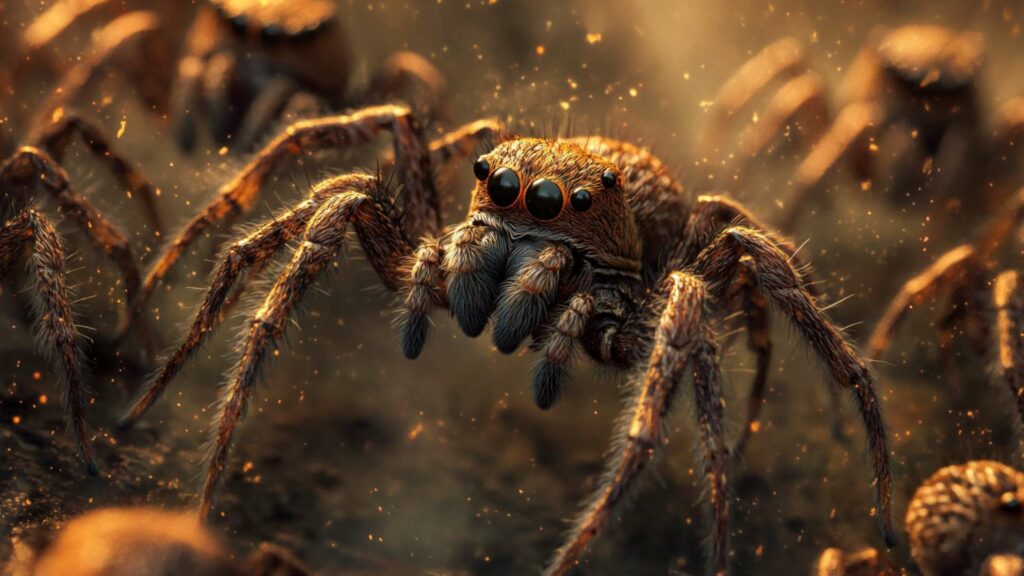
Spiders, despite their small size, possess remarkable visual abilities that contribute to their survival and hunting tactics. While most people associate spiders with having eight eyes, it is important to note that not all species house spiders have the same number or arrangement of eyes. In fact, different pairs of eyes serve distinct functions.
For instance, jumping spiders (a family known for their acute vision) have four large forward-facing eyes that provide excellent depth perception and color vision. These eyes enable them to accurately judge distances when pouncing on prey or navigating intricate environments such as tree branches or leaves.
Additionally, other spider species may possess various arrangements of eyes that cater to different light conditions and hunting techniques. Nocturnal spiders, such as smaller species like the orb-weavers or wolf spiders, often have larger primary median eyes for better low-light vision.
This adaptation allows them to detect motion and capture prey even in dimly lit environments like moonlit nights or dense vegetation. Furthermore, some diurnal species exhibit keen sensitivity to ultraviolet light, harnessing this ability to locate flowers as potential sources of nectar-rich insects.
Vibrations and touch sensitivity
In addition to their visual capabilities, spiders also rely on vibrations and touch sensitivity as crucial sensory mechanisms for perceiving their environment. On the legs of most spiders are specialized sensory hairs called trichobothria which function like tiny antennae. These hairs are incredibly sensitive to vibrations in the air or surfaces they encounter while moving through their habitat.
By utilizing these trichobothria, they can detect subtle disturbances indicating the presence of potential predators or prey. Spiders also employ tactile communication during courtship rituals or aggressive encounters with rivals.
During courtship, males may engage in elaborate dances using leg movements combined with touch-sensitive signals exchanged through distinct body postures and gentle taps on the female spider’s web or body surface. Similarly, territorial disputes between male spiders can involve complex interactions, where tactile signals are employed to establish dominance or deter rivals.
Sensory hairs on legs for detecting vibrations in the environment
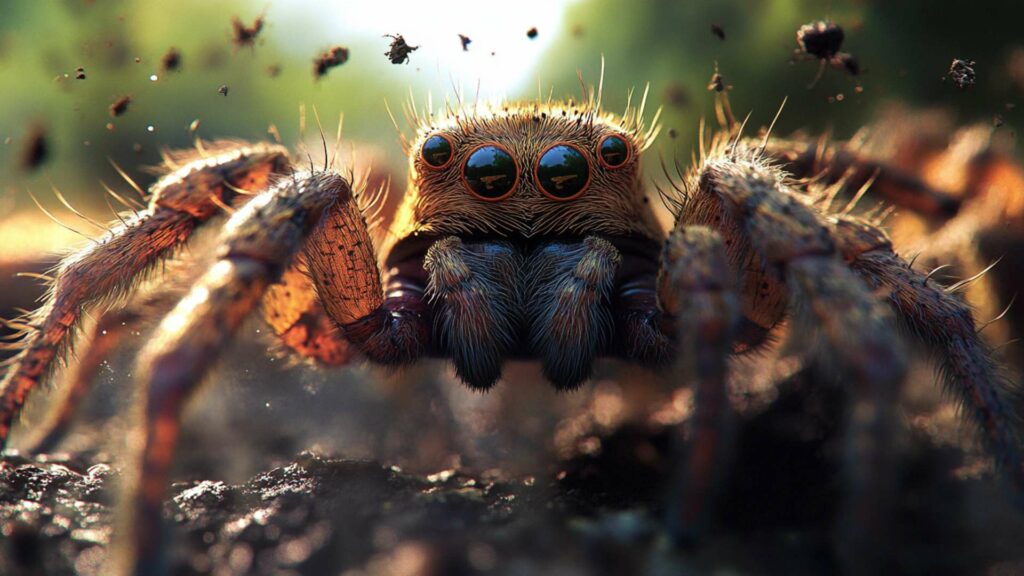
Sensory hairs on the spider’s legs play a crucial role in detecting vibrations in their surroundings. These specialized hairs, referred to as trichobothria, are extremely sensitive to even the animal’s slightest movements or disturbances. As spiders move through their habitat, these hairs detect air currents and ground vibrations caused by potential prey or approaching predators.
This sensory information is transmitted to specialized receptors that allow the spider to respond accordingly. The function of trichobothria goes beyond mere detection; they also aid spiders in identifying prey caught within their webs.
When an insect becomes entangled, it struggles and produces vibrations that travel along the strands of silk. The trichobothria on a spider’s legs pick up these minute vibrations and provide crucial information about both the location and size of struggling prey.
This allows the spider to swiftly approach its trapped victim with precision and efficiency. Overall, spiders possess an intricate array of sensory adaptations that enable them to survive and thrive in various habitats.
Their remarkable vision capabilities, together with their sensitivity to vibrations and touch, provide them with a multifaceted perception of their surroundings. Whether they rely more on sight or touch depends on their species and ecological niche but one thing is certain: spiders have evolved ingenious ways to navigate their world with astonishing precision.
Spider Locomotion
Walking Techniques
Spider locomotion is a fascinating aspect of their behavior, with various techniques employed for efficient movement. One prominent method is the alternating tripod gait, which involves moving three legs on one side of the body simultaneously, followed by the other three on the opposite side.
This coordinated movement pattern maximizes stability and minimizes energy expenditure as spiders traverse their habitats. By maintaining at least three legs in contact with a surface at all times, they achieve remarkable balance and agility.
Furthermore, spiders possess adhesive pads on their feet that enable them to climb vertical surfaces effortlessly. These pads are covered in tiny hairs called setae that produce van der Waals forces—weak molecular attractions between surfaces—to create adhesive properties.
This adaptation allows spiders to scale walls, glass panes, and even ceilings with ease without food through. The adhesive pads play a crucial role in hunting strategies as well since they allow spiders to swiftly traverse intricate webs or gain advantageous positions for ambushing prey.
Balloon Flight Mechanism
Spiders exhibit another incredible form of locomotion known as the balloon flight mechanism. Certain spider species have developed an ingenious way to catch wind currents using silk threads for aerial dispersal over vast distances. The process begins when a spider elevates its abdomen into the air while producing multiple silk strands from specialized spinnerets found at the rear of its body.
These strands become entangled into a structure called a dragline or ballooning line. Once the dragline is released into the wind, it serves as an anchor point while additional threads are produced and emitted upward by the spider’s spinnerets.
As these silk lines catch air currents, they create enough lift to carry even small juvenile spiders aloft. Spectacularly, some ballooning events have seen thousands of tiny spiderlings take flight together—a phenomenon known as “spider rain.” This mechanism allows spiders to disperse over vast distances, colonizing new habitats and avoiding competition with larger species for resources.
In addition to locomotion, spiders also employ various techniques for hunting prey, as discussed in the previous section. Their diverse hunting strategies cater to their specific dietary needs and unique adaptations.
Spider Hunting Strategies
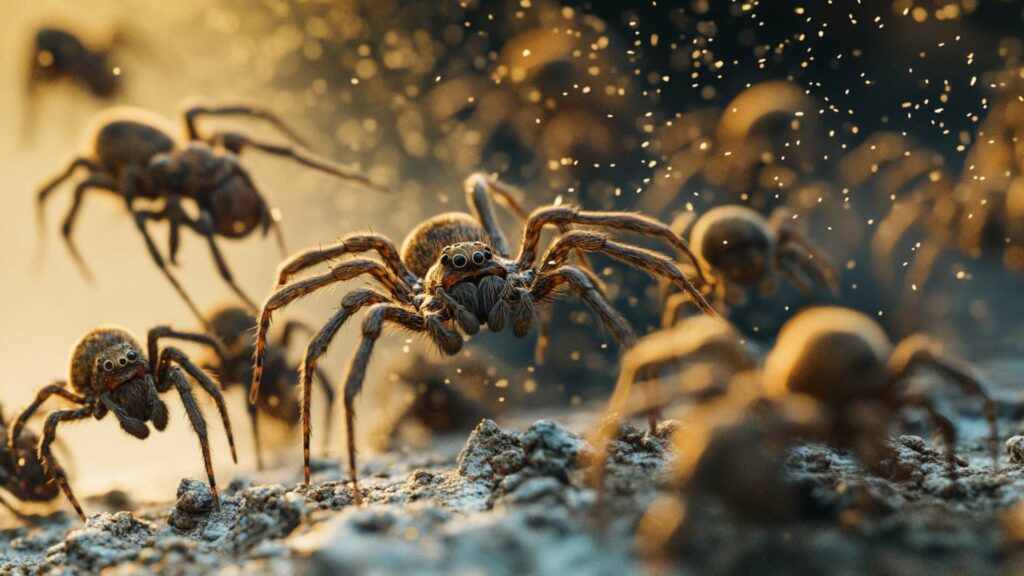
Web-building spiders
Web-building spiders are renowned for their intricate and elaborate constructions, which serve as both homes and hunting grounds. Among these skilled weavers are the orb-weavers, sheet-web weavers, and the elusive funnel-web spiders. These arachnids meticulously construct their webs using silk produced from specialized spinnerets located at the rear of their abdomen. 1. Construction process of orb webs, sheet webs, funnel webs, etc. Orb-weaving spiders build circular or spiral-shaped webs that are suspended between trees or other structures. They begin by releasing a gossamer thread into the air to catch onto a distant anchor point. Gradually, they construct radial lines connecting the central hub to surrounding structures and then build concentric circles using sticky silk threads to ensnare unsuspecting prey. Sheet-web weavers create flat horizontal sheets composed of non-sticky silk lines interspersed with adhesive water droplets, known as gumfoot lines. These sheets act like trampolines when disturbed by prey, propelling them toward the waiting spider. Funnel-web spiders employ a slightly different strategy by constructing tubular retreats connected to outlying trip lines that extend away from the den entrance. When an insect crosses these trip lines, it triggers vibrations that alert the spider to its presence. 2. Web maintenance and repair behaviors To ensure maximum effectiveness, web-building spiders invest significant effort in maintaining and repairing their delicate creations. They use their legs and specialized combs called calamistrums to comb out debris or trapped insects from their silken threads. In cases of damage or deterioration caused by weather conditions or struggling prey, web-building spiders meticulously repair damaged sections by spinning new silk threads across gaps or reinforcing weak areas with additional strands. 3. Prey capture techniques using sticky silk or trap lines The primary hunting technique employed by web-building spiders is the usage of sticky silk threads. These threads are covered in glue-like substances that ensnare unsuspecting insects, immobilizing them for consumption. Once prey becomes entangled in the sticky strands, the spider quickly detects the vibrations and movements through sensory hairs on its legs, alerting it to potential meals. Additionally, some web-building spiders employ trap lines or trip lines that alert them to prey’s presence when disturbed. These lines act as an alarm system for the spider, enabling it to react swiftly when an insect triggers the line.
Non-web-building spiders
While many spiders rely on elaborate webs for hunting success, there are several groups of non-web-building spiders that employ alternative strategies to catch their prey. a. Ambush predators: camouflage techniques, waiting in ambush positions Ambush predators such as crab spiders and wolf spiders utilize camouflage techniques and lie in wait for unsuspecting prey to pass by. Crab spiders blend seamlessly with flowers or foliage, remaining motionless until a suitable insect comes within striking distance. Similarly, wolf spiders hide amidst leaf litter or burrow into the soil while patiently awaiting their next meal. b. Pursuit predators: stalking, chasing, and pouncing on prey Pursuit predators like lynx spiders and fishing spiders actively hunt their prey without relying on traps or webs. They possess excellent vision capabilities and agile movements that allow them to stalk potential victims stealthily before launching a swift chase and capturing their quarry with precision. c. Jumping Spiders: unique hunting style using quick jumps Jumping spiders are known for their exceptional agility and astute hunting techniques. With acute vision granted by multiple pairs of eyes situated atop their cephalothorax, these tiny acrobats meticulously plan each jump as they stalk insects with deliberate caution before pouncing upon them with remarkable accuracy. These diverse hunting strategies showcase just how adaptable and resourceful spiders are in securing their meals. Whether they rely on meticulously crafted webs or employ other cunning techniques, these incredible arachnids masterfully exploit their natural abilities to survive and thrive in their environments.
Spider Diet and Feeding Habits
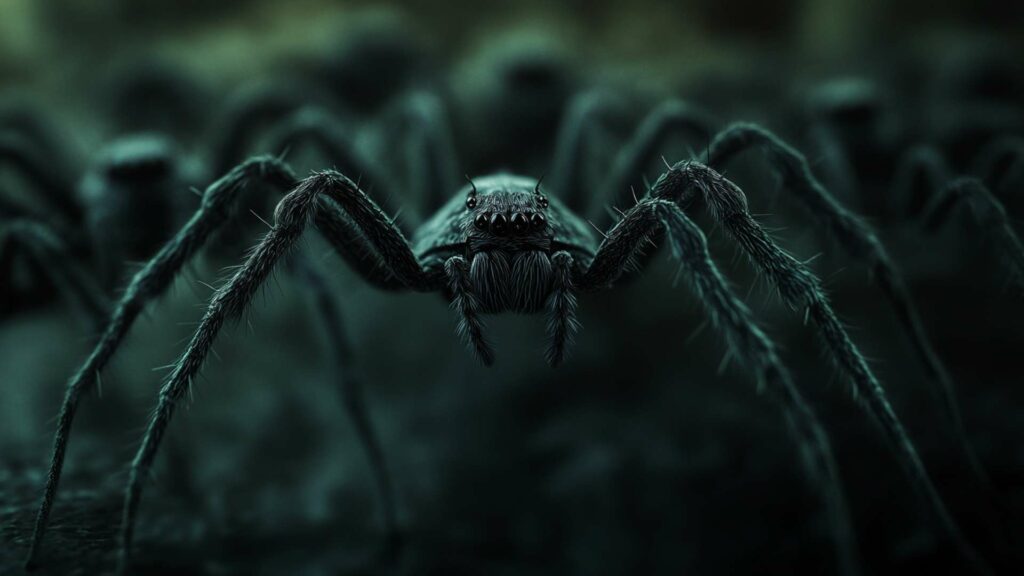
Generalist versus Specialist FeedersSpiders exhibit a remarkable diversity when it comes to their dietary preferences, which can be broadly categorized as generalist or specialist feeders. Generalist spiders possess a broader range of prey choices, allowing them to adapt readily to different food sources available in their habitat. These opportunistic predators display an adaptive advantage by being less reliant on specific prey items. For example, the common house spider (Tegenaria domestica) is known to consume various insects such as flies, mosquitoes, and even other small spiders. Conversely, specialist spiders have evolved specific adaptations for capturing and consuming particular prey. For instance, the famous orb-weaving spider (Araneidae) constructs intricate webs designed to snare flying insects like moths and beetles. Their webs are meticulously engineered with sticky silk strands that serve as a trap for unsuspecting insects. This exceptional specialization allows these spiders to focus on capturing a specific type of prey efficiently.
Digestion Process Inside the Spider’s BodyOnce a spider successfully captures its prey, it employs an ingenious digestive process that takes place primarily internally within its body. Unlike humans who chew and physically break down food before digestion begins, spiders rely on external digestion through the use of venomous fangs or chelicerae located near their mouths. When a spider catches its prey within its web or through active hunting techniques like stalking or pouncing, it swiftly immobilizes it by injecting venom into the unfortunate victim’s body. This venom serves two important purposes: first, it paralyzes the prey so that it cannot escape; secondly, it starts breaking down the internal tissues of the captured organism by initiating external digestion. The venom contains enzymes that rapidly liquefy the internal organs of the immobilized insect or other arthropod. Consequently, the spider can then use its specialized mouthparts to suck up the resulting liquid, essentially drinking its prey’s liquefied insides. This process allows for efficient nutrient extraction, ensuring that the spider obtains vital energy and sustenance from its captured prey.
Conclusion:
Spiders mesmerize us with their extraordinary diet and feeding habits. From generalist hunters that adapt to different food sources to specialist feeders with highly specialized adaptations for specific prey, these fascinating creatures demonstrate a diverse range of survival strategies in their quest for nourishment. Their unique digestion process, which involves injecting venom and externally digesting their prey’s internal organs before drinking up the liquified remains, showcases a remarkable efficiency in extracting nutrients. Understanding spider diet and feeding habits not only enhances our knowledge of these incredible arachnids but also contributes to our appreciation of their ecological significance. By controlling populations of insects and other arthropods that may pose threats or become pests, spiders play a vital role in maintaining balanced ecosystems. So let us admire these misunderstood eight-legged marvels for their remarkable hunting skills rather than harboring fear or misconceptions about them.
Frequently Asked Questions:
Spider behavior varies by species but often involves hunting, web-building, and reproduction.
Five common characteristics of spiders include eight legs, two body parts, silk production, venomous fangs, and an exoskeleton.
The eight defining characteristics of spiders are segmented bodies, chelicerae, pedipalps, silk glands, spinnerets, book lungs, eight legs, and an exoskeleton.
Special characteristics of spiders include their ability to spin silk for webs and silk-producing glands, as well as their role as predators in various ecosystems.

